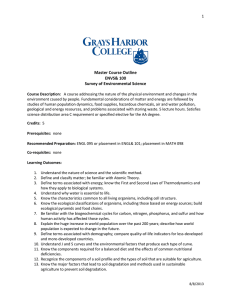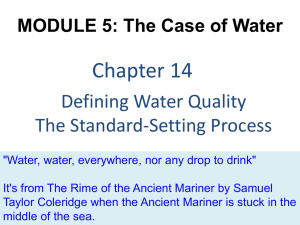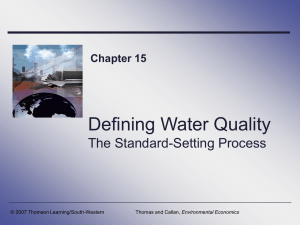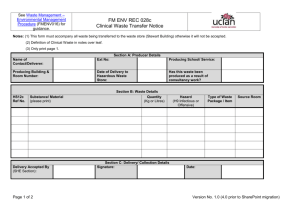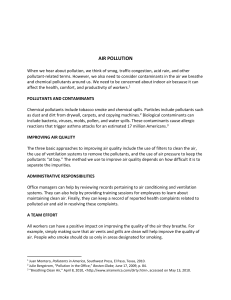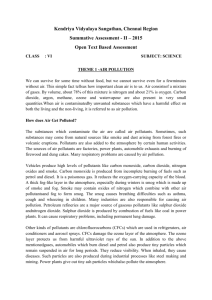Green Chemistry Glossary
advertisement
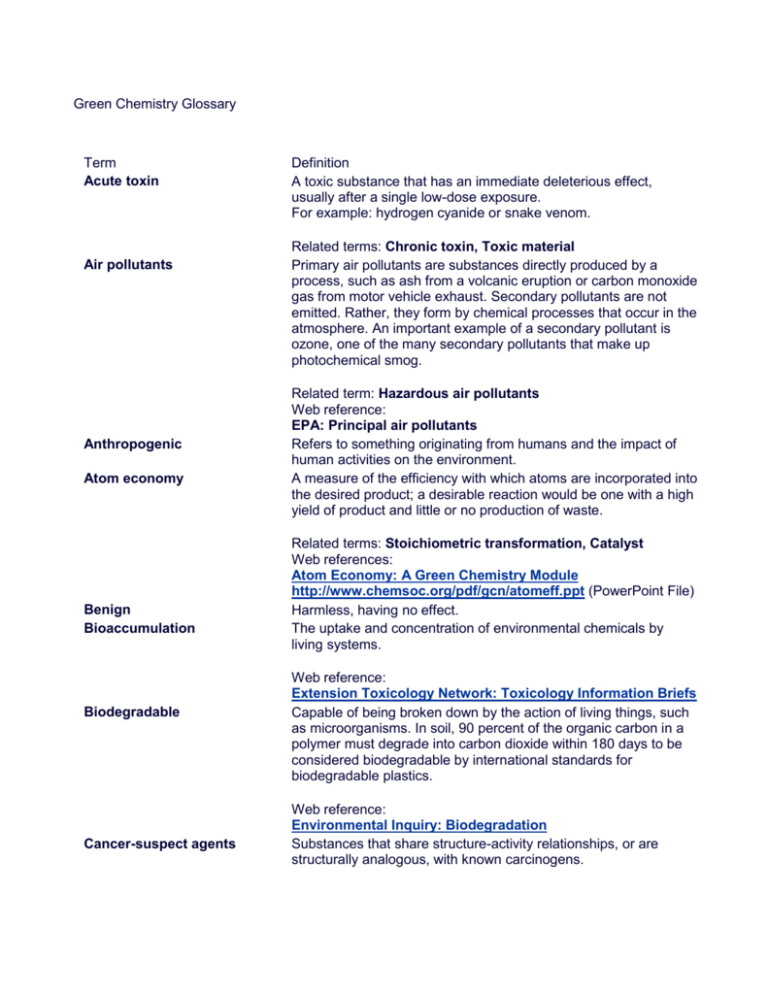
Green Chemistry Glossary Term Acute toxin Air pollutants Anthropogenic Atom economy Benign Bioaccumulation Biodegradable Cancer-suspect agents Definition A toxic substance that has an immediate deleterious effect, usually after a single low-dose exposure. For example: hydrogen cyanide or snake venom. Related terms: Chronic toxin, Toxic material Primary air pollutants are substances directly produced by a process, such as ash from a volcanic eruption or carbon monoxide gas from motor vehicle exhaust. Secondary pollutants are not emitted. Rather, they form by chemical processes that occur in the atmosphere. An important example of a secondary pollutant is ozone, one of the many secondary pollutants that make up photochemical smog. Related term: Hazardous air pollutants Web reference: EPA: Principal air pollutants Refers to something originating from humans and the impact of human activities on the environment. A measure of the efficiency with which atoms are incorporated into the desired product; a desirable reaction would be one with a high yield of product and little or no production of waste. Related terms: Stoichiometric transformation, Catalyst Web references: Atom Economy: A Green Chemistry Module http://www.chemsoc.org/pdf/gcn/atomeff.ppt (PowerPoint File) Harmless, having no effect. The uptake and concentration of environmental chemicals by living systems. Web reference: Extension Toxicology Network: Toxicology Information Briefs Capable of being broken down by the action of living things, such as microorganisms. In soil, 90 percent of the organic carbon in a polymer must degrade into carbon dioxide within 180 days to be considered biodegradable by international standards for biodegradable plastics. Web reference: Environmental Inquiry: Biodegradation Substances that share structure-activity relationships, or are structurally analogous, with known carcinogens. Carbon dioxide Carbon monoxide (CO) Carcinogen Catalyst Chlorofluorocarbons Chronic toxin Related terms: Carcinogen, Endocrine disruptor, Mutagen, Structure-Activity Relationship, Teratogen, Toxic material A heat trapping gas that plays a role in global warming. As more carbon dioxide permeates the atmosphere, inescapable heat is trapped in the shield surrounding the earth. Carbon dioxide also has applications as a solvent in green chemistry because it is nontoxic, non-flammable, recycleable, and inexpensive. It can be used as a reaction medium or alternative solvent. A poisonous, local air pollutant produced when fuel such as petroleum does not burn completely (road vehicles account for 90% of emissions). Related term: Hazardous air pollutants Web Reference: EPA:Protect Your Family and Yourself from Carbon Monoxide Poisoning A substance that has been proven, by direct correlation in epidemiological studies, to cause cancer in humans. For example: benzene or carbon tetrachloride. Related terms: Cancer-suspect agent, Endocrine disruptor, Mutagen, Structure-Activity Relationship, Teratogen, Toxic Material Web References: National Cancer Institute A substance that increases the rate at which a chemical system approaches equilibrium without being consumed in the process; advantages include reduced energy and material requirements, greater selectivity, easier product separation, and fewer waste products. Related terms: Atom Economy, Stoichiometric Transformation WebReferences: NCBI : The Central Role of Enzymes as Biological Catalysts (CFCs) Compounds used in refrigeration and aerosols; use is now regulated due to their destructive impact on the stratospheric ozone layer. Related terms: Ozone Web References: CMDL: Chlorofluorocarbons (CFCs) A toxic substance that has little immediate effect; adverse effects accumulate over repeated exposures, after a long duration single exposure, or long after an initial exposure. For example: benzene or lead. Related terms: Acute toxin, Bioaccumulation, Carcinogen, Lead, Toxic material Endocrine disruptor Feedstock Green chemistry Green engineering Greenhouse gases Hazardous Air Pollutants (HAPs) Hazards Hydrocarbons A synthetic chemical that blocks, mimics, or otherwise interferes with naturally produced hormones. Related terms: Teratogen, Toxic material Web References: World Wildlife Fund: Global Toxics The source of starting material for a chemical reaction, ideally from a renewable resource rather than a rapidly depleting one, or from the “waste” of another process. The design of chemical products and processes that reduce or eliminate the use and generation of hazardous substances. Related term: Sustainability Web References: American Chemical Society: Green Chemistry Institute 12 Principles page ? EPA page? The design, commercialization, and use of processes and products that are feasible and economical while minimizing the generation of pollution at the source and the risk to human health and the environment. Related term: Sustainability Gases that raise the temperature of the earth’s atmosphere by absorbing part of the long-wave radiation reflected back from the earth's surface; include carbon dioxide, nitrogen oxides, etc., from natural and man-made sources. Related terms: Anthropogenic Web References: EIA: What Are Greenhouse Gases? Chemicals which, when released into the atmosphere, can cause adverse effects to human health or the environment. Almost 200 of these chemicals have been identified, including chemicals that can cause cancer or birth defects. Related terms: Hydrocarbons, Organic solvents, Oxides of nitrogen, Sulfur dioxide, Volatile organic compounds WebReference: DEP: Hazardous Air Pollutants The full range of threats to human health and the environment. Related terms: Precautionary principle, Risk A general term for organic compounds that contain only hydrogen and carbon, e.g. petroleum; contribute to air pollution when released into the atmosphere. Related terms: Hazardous air pollutants Industrial ecology Lead Life-Cycle Assessment (LCA) Web References: EPA: Mobile Source Emissions - Past, Present, and Future Hydrocarbons The study of the physical, chemical, and biological interactions and interrelationships both within and between industrial and ecological systems. A heavy metal element formerly added to gasoline and paint for improved performance characteristics; ingestion and accumulation in humans result in damage to the central nervous system and the mental development of children. Related terms: Chronic toxin, Toxic material An objective process to evaluate the environmental burdens associated with a product, process, or activity by identifying energy and materials used and wastes released to the environment; used to evaluate and implement opportunities for environmental improvements. If you have a comment, addition, or update to this glossary, please send them in an email to gci@acs.org


